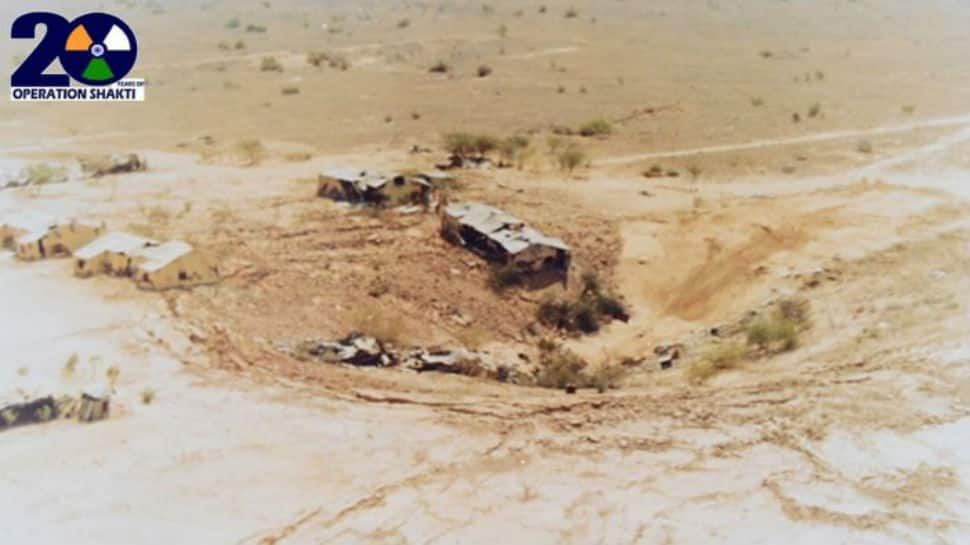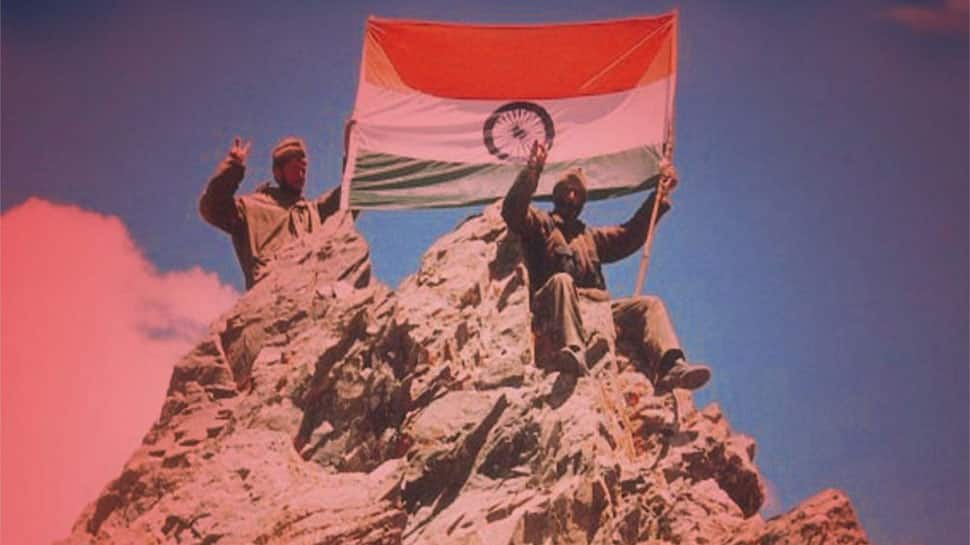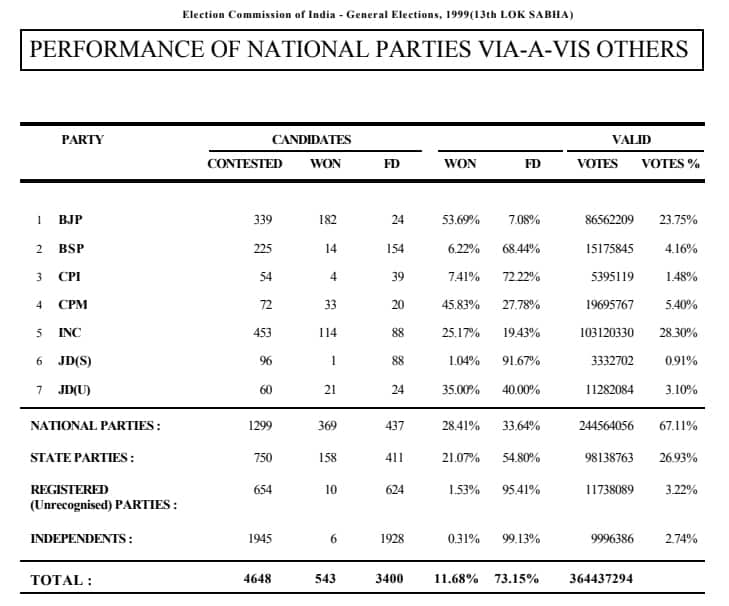INKredible India: The story of 1999 Lok Sabha election - All you need to know
The need for Lok Sabha election in 1999 was triggered by AIADMK withdrwing support to the government under Atal Bihar Vajpayee at the time. What happened in the preceeding months would have shape not just the election but the country's future going into the new millenium.
Trending Photos
)
By the late 1990s, the political landscape of India was defined by two major camps in the country. On one side was Congress, the traditional giant that may have lost its aura from past decades but was still a national force to reckon with. It had a several alliance members who may not have sworn their allegiance but tagged along nonetheless. The final few years of the decade also saw yet another internal rift within the party with many calling for Sonia Gandhi to take over the reins while veteran leader Sharad Pawar rising up to question her Italian origins.
On the other end of the field was the Bharatiya Janata Party (BJP), a rising force that had managed to have its first PM by 1996 after going from strength to strength in each passing year of the decade.
Atal Bihari Vajpayee was indeed an eloquent political figure commanding respect across party lines and affiliations and had taken over as PM twice even if his stay in power was woefully short each time so far. While Vajpayee’s first term as PM lasted all of 13 days, he won the 1998 election along with BJP’s alliance partner to take the chair once again.
Two elections in two years, however, had not evoked much confidence in the Indian political system. Regional and coalition compulsions remained as high as ever even after the 1998 Lok Sabha election in which the BJP had won 182 on its own merit. The National Democratic Alliance (NDA) would form the government and remain in power for a period which may have been short – little over a year - but was extremely eventful. The period would also see opposition within Congress to Sonia becoming party president reach its peak. By May of 1999, Pawar, PA Sangma and Tariq Anwar had moved out of the party.
With one main party on sticky wicket and its main rival dealing with the responsibilities of governing the country as well as keeping its alliance members content, 1999 saw events that would have a lasting impact on the country and its people.
Internal rift to Sonia Gandhi’s rise:
Congress was only a shadow of its former self for most of the 1990s. The assassination of Rajiv Gandhi in 1991 had left it without a leader from the Gandhi family and its fortunes had dipped significantly. Whether the dipping fortunes was because no Gandhi was at its helm or due to other factors remains a matter of debate and speculation.
By the mid 1990s, there was a strong call within the Congress to have Sonia Gandhi take over as party president. The defeat in the 1996 election had only helped her supporters raise their voice even further. The senior leadership of Congress had begun doubting the abilities of Sitaram Kesri who was heading the party at that point in time and eventually paved the way on which Sonia joined the party during Congress’ Calcutta Plenary Session in1997. A year later, she would be made the party chief, despite no political experience or acumen. Soon after, and despite massive opposition within the party, she would be made the president.
This resulted in a massive uproar with Congressmen like Pawar, Sangma and Anwar protesting against someone of Italian origin being made the party chief. Their critics say the trio had their own ambitions of becoming Congress president but whatever be the case, the three senior party leaders opting to resign would have significant ramifications for Congress.
The charge that Sonia was of Italian origin was picked up by rival parties as well which would further hurt the Congress.
Pokharan II:

Soon after becoming Prime Minister yet again, Vajpayee decided to put India on the nuclear map which would be a massive statement on the world stage.
The government of the time showed steely determination to take a massive risk and conduct a series of nuclear tests at Pokharan in Rajasthan between May 11 and 13 of 1998. At the time, there was big risk of international backlash as well as domestic criticism but in hindsight, the tests – conducted against odds and under complete secrecy - not only made India into a nuclear nation but stamped BJP as a party which could take effective decisions in the interest of the country. Even in the immediate aftermath of the tests, Vajpayee remained steadfast even as the US promised sanctions galore. The promised backlash was only a trickle which also added to the government’s credibility.
Kargil War – May 3 to July 26 of 1999:
It has been argued in the past that the government in 1998 may have conducted the Pokharan nuclear tests but had failed to assess all the potential risks associated with its aftermath. Kargil war with Pakistan is, by a few, seen as Pakistani military establishment’s response to India going nuclear and their effort to escalate the Kashmir conflict to the international stage at a time when the international community was largely condemning the tests.
The eventual outcome of Kargil War – even at the cost of great human sacrifice – however showed the Vajpayee government as one with a steely resolve to meet with any challenge. The intruders – Pakistani soldiers in the garb of being mercenaries and guerrillas, occupied vantage peaks on the Indian side of LoC. The intrusions were made in Kaksar near Kargil, Marpo La in Dras and in the Batalik sector. The objective of a nefarious Pakistani force was to keep a hold on peaks here till the international community intervened and forced a ceasefire which would enable them to cement their hold.
The Indian retaliation, once the intrusions were detected, was valiant and fierce. The Indian Army fought an uphill battle – quite literally – to drive the intruders out while at no time did Indian forces cross the LoC. Also called Operation Vijay, it is among India’s most decisive military wins against Pakistan and one that further showcased the ability of the Vajpayee government to handle a massive crisis. It became a key point in the NDA manifesto before the call for election later in the year.

Election 1999 – Status of States:
The Lok Sabha election 1999 was conducted across 32 states and union territories in India. These were:
Andhra Pradesh
Assam
Arunachal Pradesh
Bihar
Goa
Gujarat
Haryana
Himachal Pradesh
Jammu and Kashmir
Karnataka
Kerala
Madhya Pradesh
Maharashtra
Manipur
Meghalaya
Nagaland
Orissa
Punjab
Rajasthan
Sikkim
Tamil Nadu
Tripura
Uttar Pradesh
West Bengal
Andaman and Nicobar Islands
Chandigarh
Dadra and Nagar Haveli
Daman and Diu
National Capital Territory of Delhi
Lakshadweep
Pondicherry
Political parties in the fray:
There were seven national parties and another 40 state parties which contested the Lok Sabha 1999 election, apart from many other registered (unrecognised) parties. These were:
National Parties:
Bharatiya Janata Party
Bahujan Samaj Party
Communist Party of India
Communist Party of India (Marxist)
Indian National Congress
Janata Dal (Secular)
Janata Dal (United)
State Parties:
Arunachal Congress
All India Anna Dravida Munnetra Kazhagam
Asom Gana Parishad
All India Trinamool Congress
Biju Janata Dal
Dravida Munnetra Kazhagam
All India Forward Bloc
Federal Party of Manipur
Hill State People’s Democratic Party
Haryana Vikas Party
Indian National Lok Dal
Jammu and Kashmir National Conference
Jharkhand Mukti Morcha
Janata Party
Kerala Congress
Kerala Congress (M)
Lok Shakti
Marumalarchi Dravida Munnetra Kazhagam
Manipur People’s Party
Manipur State Congress Party
Muslim League Kerala State Committee
Nationalist Congress Party
NTR Telegu Desam Party (Lakshmi Parvathi)
People’s Democratic Movement
Pattali Makkal Katchi
Rashtriya Janata Dal
Republican Party of India
Revolutionary Socialist Party
Shiromani Akali Dal
Samajwadi Janata Party (Rashtriya)
Sikkim Democratic Front
Shiv Sena
Samajwadi Party
Telegu Desam Party
Tamil Maanila Congress (Moopanar)
United Democratic Party
United Goans Democratic Party
United Minorities Front, Assam
Election 1999:
BJP and its alliance partners, including AIADMK, had formed the government in 1998 and had looked like stability would return to Indian politics. AIADMK had managed to win 30 seats in Tamil Nadu and its support was crucial in helping BJP forming the next government as its biggest member.
But fissures soon emerged.
Vajpayee had flatly refused to dismiss the DMK government in Tamil Nadu which would have otherwise given a chance to AIADMK to form the government in the state. In addition, the PM had also refused to have a corruption case against Jayalalithaa dropped. This led to AIADMK pulling back its support. Consequently, the Vajpayee-led government lost the confidence vote in Lok Sabha by a solitary vote.
Congress, now under Sonia, was unable to draw the numbers, prompting President KR Narayanan to dissolve the Parliament and have election in the country yet again.
Gone were the years of triangular and quadrangular battles of the 80s and most of 90s which saw fractional camps threatening to leave an impact on the eventual outcome of elections. The Lok Sabha election of 1999 was essentially a battle between the BJP-led alliance and the Congress-led alliance. The battle lines were drawn clearer than ever before.
Did it then have the potential to make this contest more predictive than thrilling? It didn’t.
The BJP, however, did enjoy an edge at the time the NDA government was dissolved and fresh election was called by President Narayanan. The party was still several years away from conquering southern and eastern India on its own merit but had been relentlessly fine-tuning its political relations with alliance members through the topsy-turvy lanes of coalition politics.
The rift with AIADMK – the biggest reason which led to calling of fresh election – had the potential of hurting BJP in Tamil Nadu but it still had some formidable regional players – like TDP – by its side.
The Congress, on the other hand, was fighting against a double-edged sword. The party had to once again deal with the rising might of BJP was also busy firefighting within. The rise of Sonia and the exit of Pawar, Sangma and Ahmed resulted in a party that could lose out on traditionally assured seats.
As for the remaining forces unwilling to commit to one side or the other, the prospect of post-poll alliance remained open.
Campaigning for Lok Sabha election 2019 was as intense as ever with BJP, Congress and smaller parties rousing sentiments of voters while trading accusations galore.
The NDA manifesto – titled ‘For a proud and prosperous India’ – was more about highlighting the strong decision-making abilities of the government under Vajpayee than what was ahead of the country. Most interestingly, the manifesto began with these words:
“The 1999 General Election is an unnecessary imposition. It was thrust upon the country by a motley combination that put political negativism, narrow personal interests and greed for power far above the national good.”
The manifesto went on to slam Congress for being unable to stitch together a ‘negative coalition’ and thrusting a fresh election on the country.
More significantly, the manifesto also highlighted, then underlined, the achievements of the past several months and the Kargil War received special mentions.
“The Government rose to the challenge and acted decisively. Faced by this aggression in Kargil, the response of the Government was swift, though measured. The last of the Pakistani intruders were cleared from the Kargil Sector on 27th July. We salute the heroism, dedication and selflessness of our armed forces. We dedicate ourselves anew to preserving the honour and territorial integrity of our motherland. We reiterate our commitment to look after the welfare of the armed forces, and of the dependents of all those that laid down their lives in service of our motherland.”
The manifesto also stressed that the NDA was committed to national security, dynamic diplomacy, federal harmony, economic modernisation, secularism, social justice and transparency and corruption-free governance.
The NDA also promised to ensure inclusiveness and quite significantly, dropped the Ram Temple in Ayodhaya issue for the first time since 1991. It is believed that this was done to satisfy some of the alliance members within the NDA.
Congress, on the other hand, continued with the main features of its manifesto from just a year earlier, trying to woo voters with lofty promises of addressing poverty, strengthening the economy and creating jobs. It also accused the NDA members of making national interest secondary to their own political ambitions.
Under such a charged-up atmosphere, the Lok Sabha election 1999 was held between September 5 and October 3 of that year.
Election was held across 545 parliamentary constituencies in a total of 32 states and union territories in the country.
The number of candidates battling it out in this edition had come down to 4,648 which remains the lowest in all Lok Sabha elections in the country since 1980. This number had peaked in 1996 when 13,952 candidates had filed their nomination, prompting the Election Commission of India to hike deposit fees significantly thereafter.
The size of the electorate had jumped by a crore and 50 lakh to almost 7 crores who were eligible to cast their vote in 7.74 lakh polling booths across the country.
The election was held over the course of five days and while there were strong speculations that there was a sense of voter fatigue owing to this being the third Lok Sabha election in as many years, the overall voter turnout figure of 59.99 per cent – almost at par with turnouts at the time – was a step in the correct direction.
A low voter turnout could have damaged some of the prospects for the NDA in this election but it was not meant to be as the BJP and its alliance partners registered a solid performance by winning 270 seats and an additional 29 won by TDP. BJP secured wins in 182 seats which was a shade better than its own showing a year ago while its vote share had dipped a bit to 23.8 per cent, perhaps because it contested in lesser seats than in 1998. Critics of the party also sought to highlight how BJP fared poorly in Uttar Pradesh where the party won just 29 seats. In the larger scheme of things, it won’t matter because BJP’s biggest achievement was in holding the right hands as alliance partners carried the NDA’s proverbial flag right into the Parliament.

The Congress, however, had to hunt for positives at the end of the 1999 Lok Sabha election. The country’s oldest political party had managed to win 114 seats on its own while its partners in AIADMK and RJD won 10 and seven, respectively. Both Jayalalithaa and Lalu Prasad Yadav – leaders of AIADMK and RJD – were facing corruption charges at the time and that may have hurt Congress more than their own respective parties. The final outcome was an alarm bell for Congress as it had sought to project itself as the single-largest party and one that is capable of providing the country with stability. Its own house, however, was on shaky grounds and Sonia’s rise to the party’s helm, followed by the exit of Pawar, Sangma and Ahmed had created a massive dent in Congress’ image at the time. Among the consolations were states like Karnataka and Punjab where it fared well while it managed to repair some of the damages in UP from the election last year when Congress had been absolutely routed.
The result of the 1999 election also sent a strong signal to the Left as CPI – already hobbling – was crippled and managed to win just four seats. It lost its ‘national party’ status.
Lok Sabha election of 1999 was a turning point in the politics of the country for all of these reasons, and more. It was the first time that political parties under the NDA umbrella had managed to come together in a decisive way and get the desired outcome. Vajpayee was the unanimous choice, as was obvious, to become PM again and he would complete full five years in office – providing India with stability after many years of political unpredictability. India was truly set and ready for the new millennium.
Stay informed on all the latest news, real-time breaking news updates, and follow all the important headlines in india news and world News on Zee News.
Live Tv







)
)
)
)
)
)
)
)
)
)
